Gary Omlin, Top Fuel Renegade
By David Hapgood
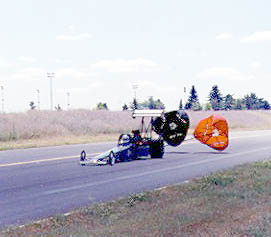
Gary slows at Spokane. Photo by Jim Burke
Gary Omlin has been running Top Fuelers down West Coast drag strips
since 1975. I'd guessed as much three years ago when I first stopped by
his pit and watched him fire the car up: the man's presence indicated a
lifetime in and around Top Fuelers. A few months ago, when I first
suggested doing this story, Gary matter-of-factly agreed to go along with
it. He didn't have to tell me not to glorify his self-financed career.
What follows is a basic account of his grassroots and unorthodox approach
to Top Fuel racing.
Omlin is a lifelong resident of Quincy (population
3,738), a farming community in central Washington state. His racing career
began in March 1974 with the purchase of an injected front engined
dragster from a man who would become, briefly but significantly, the
principal mentor of his career: Henry "Hank" Eisler Jr. Omlin
had never driven any sort of racecar before climbing into the dragster for
a series of checkout passes on the sealed gravel road in front of his farm
(this WAS the ‘70s after all!). They ran the small block Chevy on gas
that afternoon and, to put it bluntly, the first pass was an eye opener.
Driving a dragster was not at all what the young Omlin
had expected. He brought the thing to a stop, wondering what the hell he'd
gotten into. Gary was debating whether to undo the belts and abandon this
scheme when Hank drove up in the push truck. Without asking Omlin whether
he was enjoying himself, Hank manually turned the car around for a second
pass in the opposite direction. In that single moment, Hank sent Omlin
over the hurdle and into a lifelong pursuit of racing.
The duo next went for licensing runs at Deer Park
Dragstrip near Spokane, tossed 25% nitro in the tank, and went 150mph on
Omlin's first day on a dragstrip. Jeb Allen and Gary Beck signed for his
initial licensing passes, while Terry Capp and alky racer Bill Phillips
signed for his final licensing runs at Mission, BC. Over the next two
summers, increasing the nitro doses incrementally to 90% produced time
slips in the mid seven second range at over 180mph.
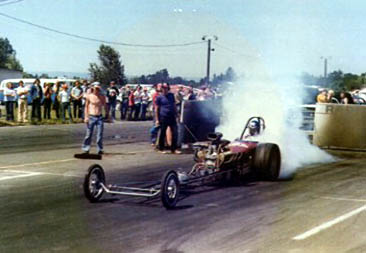
The Eisler and Omlin slingshot made its debut in 1974. Photo by Paul Hattig
While it appeared that Omlin was on the way to becoming
a regular in the Division 6 Pro Comp wars, fate intervened. In August of
1975, a Top Fuel car came up for sale and he purchased it.
And so, just a year and a half after stepping into his
first racecar, Omlin had advanced to Top Fuel. The car was a 238"
wheelbase vehicle built by Spokane chassis builder Ron Dixon and
powered by a 478" Keith Black marine motor. Shakedown runs were
conducted at Seattle International Raceway and Omlin's Top
Fuel license was signed the following Spring in Yakima by none other
than Shirley Muldowney and Don Garlits.
Racing was good in those years for a self-funded Top
Fuel team. They had nitro fields at the divisionals as well as at the
various National meets, not to mention the match races and
independent meets. Omlin brought his car out as often as the budget would
allow – Top Fuel was expensive, even then. He hit between three and five
meets per season at Northwest tracks like Portland, Seattle, and
Mission, and made the occasional foray down to Southern California. Year
by year, he improved his tuning skills -- sometimes the hard way.
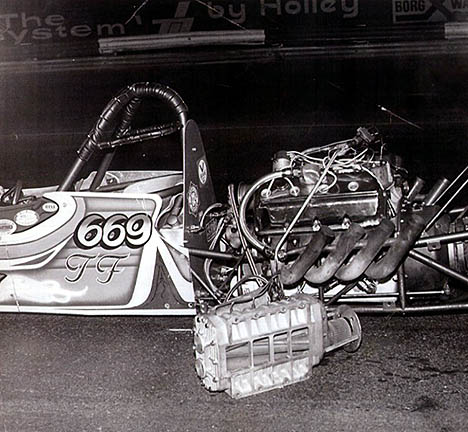
As you can see, Gary's already left the scene of the crime. Photo
copyright Ron Burch
Through trial and error, Omlin used these formative
years to learn how to run a basic Top Fuel operation.
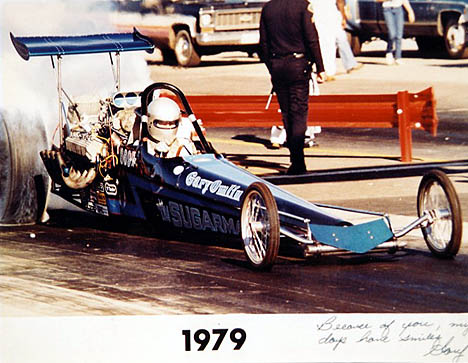
Gary at the 1979 NHRA Winternationals. Photographer unknown
In 1979, Gary had one of his finest moments at the NHRA
Winternationals at Pomona. Here's how he describes it: "Qualified #7
and lifted a blower. Garlits was in my pit on Sunday morning watching to
see if we could fix it; he was first alternate. We made first round with
Gar on the outside looking in! Raced Rob Bruins-Gaines Markley... smoked
the tires. They won and went on to become World Champions that year -- my
favorite little guy heroes. Still friends after all these years. These
stories and a hundred like 'em are the guts of this sport."
As the 1980s rolled in, the sport underwent a period of
dramatic change in how races were conducted and how racers got paid. Top
Fuel was phased out on the divisional level and whatever match races were
left dried up shortly afterwards. In just a few short years, it was a new
game and many nitro teams didn't survive the transition to the
National-Meet-Only format. Omlin, however, was really just getting
started. For the 1980 season he added a business partner, upgraded the
chassis, and headed for Pomona.
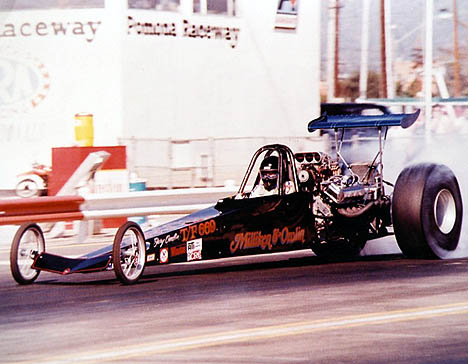
Here's the Omlin and Milliken car at Pomona. Check out the short wheelbase.
Photo by Les Welch
The Milliken/Omlin car was campaigned across the
Northwest that season, but the business partnership
dissolved after one year. Omlin once more took sole ownership of the
vehicle.
By the mid eighties, it was clear that the car had
reached its potential. Barring a major sponsorship, ordering a
new chassis was out of the question. So Omlin set out to build a new
vehicle from the old one, a complete transformation. Things were about to
get real interesting.
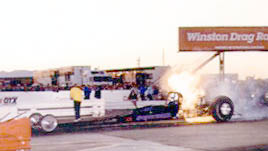
Gary fireballs the Sugarman car at Phoenix.
Photo by Auto Imagery
In the mid 1980s, Gary took on the challenge of
redesigning his racecar. He lengthened the wheelbase to 300 inches, did
away with most of the body panels, and installed a unique airfoil on the
cowl. Most dramatically, he did away with the rear wing. When the car was
completed it did not even slightly resemble the original. It was one of
the more unusual-looking fuelers.
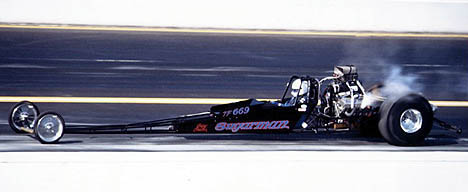
Gary drops a cylinder but keeps on moving hard. Photo by John Shanks
For Omlin, the venture was an engineering challenge: how
to push a chassis design to its complete potential. His lifelong
inclination to upgrade and improve had resulted in what I consider his
signature racecar.
When asked what it was like to drive a wingless Top
Fueler, Omlin replied that it wasn't hard. Conventional wisdom dictates
that a rear-engined fueler will almost certainly become uncontrollable
without adequate downforce. The history of wingless rear engined cars is,
essentially, a history of crashes. The Sugarman car, however, was not a
product of conventional wisdom. The airfoil on the cowl acted as a
mini-wing and Omlin felt that crashing the thing was just not going
to happen. He knew his car and still stands by the design- for a fueler
running in the 250mph range.
This phase of the vehicle came to an end several years
later, not in disaster but due to the "unwanted attention"
generated by the wingless design. To appease the tech inspectors, Omlin
added a small rear wing. Gary finished out the ‘80s in the final,
updated version of the car.
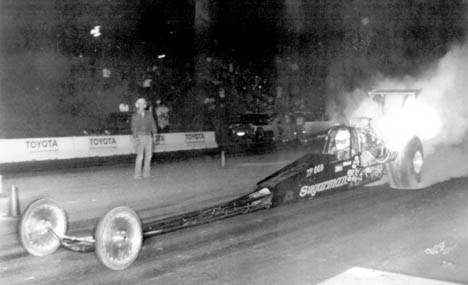
The Sugarman punishes the slicks on this awesome burnout. Photographer unknown
As the 1990s rolled in, Omlin finally said goodbye to
his longtime racecar. An Al Swindahl frame -- previously a Shirley
Muldowney ride -- had come up for sale and Omlin purchased it. Gary is
still running this car today. Continuous upgrades throughout the decade
have included a new back half and a dual element wing. He painted the car
a monotone slate gray with minimal lettering, what he calls a "no
maintenance paintjob." From a distance, it's easily mistaken for
primer. The absence of decals completes the austere visuals.
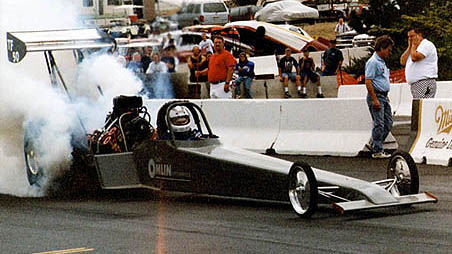
Here's Gary at the 1999 World Finals. Photo by David Hapgood
And now, a story within a story. The first time I saw
Omlin run (Spokane 1999) he'd just installed a larger fuel tank on the
car. Gary was still working out some gremlins and was having trouble
keeping the engine lit. Twice earlier in the day, Omlin had come out for
qualifying passes only to have the motor stall before the car launched.
For his final try, it was nighttime, and the stands were full. The pass
was really something else: one of those fantastic moments when you can
almost read a driver's mind by what the car is doing. After the earlier
aborted runs, Omlin was a bit peeved and WAS going to put the car down the
track this time whether it liked it or not.
This time the car launched hard, but then, like so many
other cars on that cold night, smoked the tires hard not
long after takeoff. Real hard. I could see very well that this was in no
way going to stop the run! Approaching half-track, Omlin had his foot all
the way in it. The car was way up on its tires with eight foot header
flames blasting out the pipes and the tallest plume of tire smoke I have
ever seen in my life exploding off the tires. In a sport where the
mechanical element generally obliterates the human element, I was pretty
much blown away by this display of INTENT. I was at Englishtown the night
Mark Oswald broke Don Garlits' SEVEN-year-old ET record. That was great.
This was better.
Something finally went away on Omlin's motor as he
blazed past, glowing pieces of metal skipping across the track while the
crowd went nuts. What an ABRASIVE pass! Omlin was in the program. On
raceday, he advanced in eliminations as far as the semifinals,
running 5.90s all day long.
Which brings us to the present. To this day there's no
clutch management in the car (he runs a Crowerglide and believes in the
judicious use of the brake handle) and no fuel management (he runs a Scott
centrifugal pump). He does not use -- and doesn't believe in -- a computer
in the racecar. He's run a well-maintained Bowers 10-71 blower for
years; originally, it cost him $300. He tells me he's been running from
"the same two or three boxes of pistons I bought eight years
ago." He runs a pair of low amp (8) Cirello mags. The equipment
and tune-up on this car are probably like no other. One last thing- he's
been known to run "can to can" - 100%
nitro "Where it's legal." Reflecting on his current
situation, he considers himself lucky to finally have three aluminum
blocks (JP-1s) at his disposal.
Last summer, Omlin qualified 6th at the AHRA World
Finals with a 5.636 at 252.30 mph, his career best and certainly one of
the fastest runs on a 10-71 blower. He told me he considers this pass and
qualifying for Pomona in '79 as the two highlights of his career --
so far.
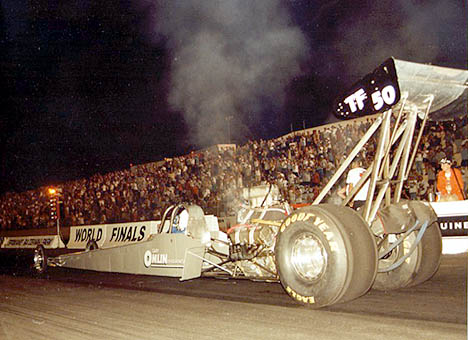
Gary Omlin's current rear engine car at the AHRA World Finals.
Photo by David Hapgood
Gary Omlin will be racing again in the Northwest this
summer with his all-volunteer crew. If you're into Top Fuel, you might
want to stop by and have a look. Gary Omlin: Owner/Tuner/Driver -- the
good old days aren't quite over yet.
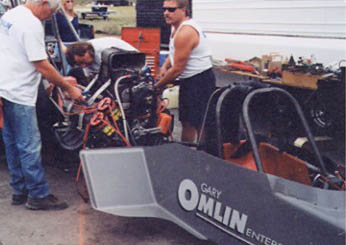
The diehard Omlin crew gets ready at Spokane. Photo by David Hapgood
David Hapgood
hapgood_d@hotmail.com